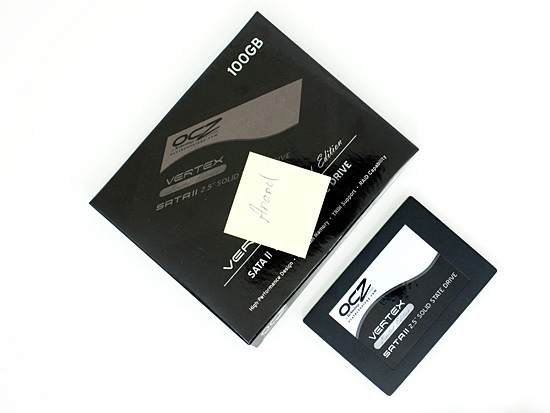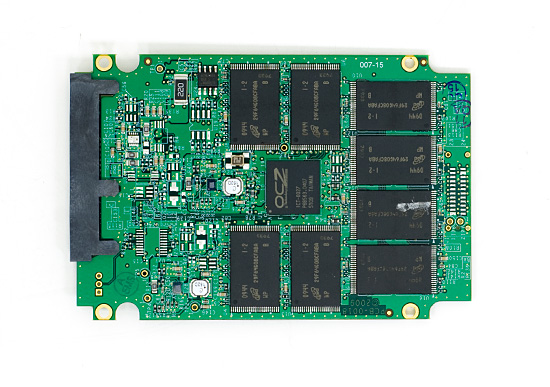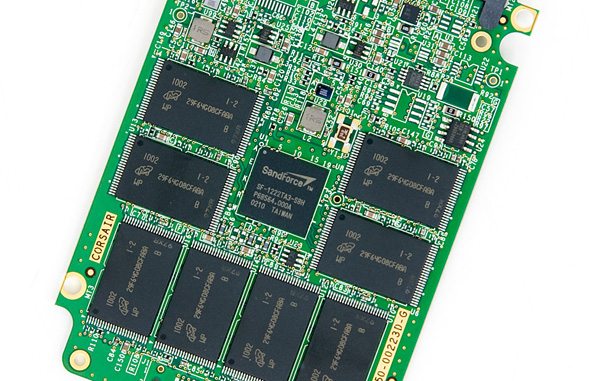Understanding SandForce's SF-1200 & SF-1500, Not All Drives are Equal
by Anand Lal Shimpi on April 16, 2010 11:30 AM ESTLess than 24 hours ago I was called into a meeting with SandForce, the SSD controller manufacturer that has been on fire lately. The company makes two controllers: the SF-1200 and SF-1500. The meeting was initiated by SandForce to clear up any misconceptions I might have about the differences between the two controllers. No good deed goes unpunished, and the quick meeting turned into an hour long debate about responsibility and ethics. It turns out that while I finally know the difference between the SF-1200 and the more expensive SF-1500, not all drives based on the SF-1200 will offer the same performance. In fact, some drives that are currently on the market will actually drop in performance (in one metric) if you upgrade them to SF’s mass production firmware. Yep.

SF-1200 vs. SF-1500
On SandForce’s site are two controller options: the SF-1500 intended for enterprise (server) customers, and the SF-1200 for client (desktop/notebook) SSDs. The first silicon ready was SF-1500, and a derivative version of that was used in the earliest drives (e.g. OCZ’s Vertex Limited Edition). More recently however we’ve seen SF-1200 based SSDs crop up, such as Corsair’s Force drive. In our recent review we found no performance difference between the Force drive and the Vertex LE, leading me to believe that there’s no tangible performance difference between the SF-1200 and SF-1500. However since then I’ve finally got a good handle on the differences directly from SandForce.

The SF-1500 controller from the original Vertex LE.
Let’s start with the obvious and what I suspected: there is no physical difference between the SF-1200 and SF-1500. It’s the same die. The difference between the two amounts to firmware, validation and settings on the chips themselves. It’s akin to Intel disabling Hyper Threading on the Core i5 750 but leaving it enabled on the Core i7 860; same die, different features.

The SF-1200 controller on Corsair's Force SSD. The chips are the same, it's all about firmware and settings.
As an enterprise class solution, the SF-1500 is designed to complete any writes in progress in the event of sudden power loss. The SF-1500 firmware is configured expecting the presence of the super cap we saw in the Vertex 2 Pro. As such it expects that it can write at full speed without any worries about power loss. In other words, it assumes you have power failure protection at the drive level.
The SF-1200 firmware on the other hand doesn’t assume the presence of a large capacitor to keep the controller/NAND powered long enough to complete all writes in the event of a power failure. As such it does more frequent check pointing and doesn’t guarantee the write in progress will complete before it’s acknowledged. It’s a subtle difference, but the SF-1500 with super cap may be necessary for some of SandForce’s enterprise customers.

The SF-1500's super cap, necessary because SandForce's controller keeps a couple of MBs of data buffered
Continuing the enterprise focus, the SF-1500 supports more SMART attributes and logging/debug/diagnostic features. SandForce wasn’t willing to elaborate on this point but said that it shares the SMART feature list with its customers under NDA. If this sort of thing might matter to you, sign a NDA with SandForce and they’ll apparently tell all.
As I pointed out in the Corsair Force review, SandForce rates the SF-1500 for a longer mean time to failure than the SF-1200. This is a basic binning/testing advantage. The SF-1500 goes through more tests and qualification than the SF-1200 allowing SandForce to guarantee higher reliability. That’s not to say that the SF-1200 won’t last as long as or longer than the SF-1500, it’s just that SandForce is willing to guarantee a longer lifespan on the SF-1500 than it is willing to do for the SF-1200. I poked fun at SF’s mean time to failure ratings in the Force review, however SandForce explained the MTTF is calculated across the entire population of controllers - not the lifespan of a single controller.
In a population of 10,000,000 controllers, with a rating of 10,000,000 hours, the probability is that 1 unit would fail in an hour. The SF-1200 would have 5 units fail in the same time. The failure probability drops as the number of controllers drops (SF won’t be shipping anywhere near 10M of these things).
While both the SF-1200 and SF-1500 support MLC NAND, the SF-1500 also supports SLC. This once again is more of an enterprise class feature as most desktop users aren’t willing to pay the 2x price premium of SLC vs. MLC NAND flash.
| SandForce Controller Comparison | ||||
| SF-1200 | SF-1500 | |||
| Flash Memory Support | MLC | MLC or SLC | ||
| Power Consumption | 550 mW (typical) | 950 mW (typical) | ||
| Sequential Read/Write Performance (128KB) | 260 MB/s | 260 MB/s | ||
| Random Read/Write Performance (4K) | 30K/10K IOPS | 30K/30K IOPS | ||
| Security | 128-bit AES Data Encryption, Optional Disk Password | 128-bit AES Data Encryption, User Selectable Encryption Key | ||
| Unrecoverable Read Errors | Less than 1 sector per 1016 bits read | Less than 1 sector per 1017 bits read | ||
| MTTF | 2,000,000 operating hours | 10,000,000 operating hours | ||
| Reliability | 5 year customer life cycle | 5 year enterprise life cycle | ||
So far none of these differences matter to a client user, but the last item on the list does. There’s a performance difference between the SF-1200 and SF-1500. The SF-1500 is capable of higher sustained small file random write speed. The SF-1200 is rated at 10,000 4K random write IOPS (sustained), while the SF-1500 is rated at 30K (sustained). This is purely a firmware limitation, but SandForce believes the 10K number is high enough for client PCs (Intel rates its X25-M G2 at 6.6K for the 80GB model and 8.6K for the 160GB model).
The controllers should otherwise perform the same, it’s only in small file random writes that there’s a difference (realistically speaking we’re talking random writes smaller than 16KB in size). SandForce notes the difference on its website, however in our testing of Corsair’s Force drive we showed absolutely no difference. So what’s going on?










81 Comments
View All Comments
superjojo - Friday, April 16, 2010 - link
I'm sorry if I'm mistaken, but while reading the article I had a feeling that Anand was kind of retaliating against SandForce for something they might have done/said at that meeting.Anand Lal Shimpi - Friday, April 16, 2010 - link
I'm not sure what's shipping to OEMs right now, but the Vertex LE is the only thing I can point at as being a SF-1500 without the supercap and some of the other enterprise features.There are more SF-1500 devices in the pipeline, but the focus is on SF-1200 as the full 1500 solution is quite pricey.
Take care,
Anand
arehaas - Saturday, April 17, 2010 - link
OCZ Vertex 2 is advertised as Sandforce-1500, and Agility 2 as Sandforce-1500. With 50,000 and 10,000 write IOPs, respectively. They have been available in Europe for two weeks already.arehaas - Saturday, April 17, 2010 - link
Sorry, a typo - Agility 2 is Sandforce-1200.SirZ - Friday, April 16, 2010 - link
Why on earth would a business want to "throttle" their product? They could make all these "business" problems go away just by giving everyone the exclusive firmware (with the power saving thing fixed, in MP mode). There has to be a better way to reward the company that stood by you from the start (OCZ) than punishing everyone else. Why not just give them a better deal? OCZ wins, customers win.Mr Perfect - Saturday, April 17, 2010 - link
I think the problem is who SandForce perceives their customers to be.The drive OEMs may be the one's writing checks to them, but it's ultimately the end user who is creating the demand.OCZ certainly should be given something extra for helping SandForce develop the tech, but giving them a SF-1200 that outperforms all other SF-1200s is at best confusing, and at worst deceptive. Give them a new SKU if you really must give them a performance edge. Call it a SF-1300 or SF-1400, and the consumer won't feel like they are being mislead.
SirZ - Friday, April 16, 2010 - link
Right now, they all lose. I have been getting ready to jump on the real SSD bandwagon (bought a 30 GB Vertex a couple months ago, still sitting in the box, to small for anything useful, call it a 90 dollar impulse buy), and this Sandforce thing has been promising, and I have been favoring some flavor of the Vertex (the cheaper ones anyway), but this silliness about sending the "better" performing product to review sites, makes me suspicious and is pushing me closer to Intel's drive. (If only it was 10-15% cheaper...)So, OCZ, Sandforce, etc... you all lose. Thanks Anand, and double thanks for not caving in to the usual corporate pressure to keeping this stuff hush-hush (I know how these review things go ;)
willscary - Friday, April 16, 2010 - link
It took a bit over 1/2 hour and being put on hold twice, but I finally got a straight answer. The 3 Mercury Extreme SSDs that I bought on Monday under the premise and specifications of the Sandforce 1500 controller do NOT have the 1500 controller, but instead the 1200 controller.I was given no explanation other than "All Mercury Extreme SSDs now shipping have the Sandforce 1200 controller onboard"
OWC had no problem offering an RMA for these drives, but I still feel cheated. The cost of the lesser controllers means that the drives should have been cheaper, but OWC decided to try to pull a "bait and switch" and pocket the extra cash. I will now be ordering OCX Vertex LEs.
Again, thank you Anand for this article. While performance may be equal, I want to know what I am buying and get what I paid for. This article, along with a quick change to the OWC website this morning, turned on the lightbulb.
Its too bad. These are probably still superb drives, but the fact that I was really misled on the components leaves me feeling like OWC attempted to get away with robbery. Luckily, as soon as caught, they are quick to comply with an RMA to make themselves look like it was a mistake, but the person on the other end of the phone was CLEARLY annoyed as he quickly sent the RMAs.
Ipreferspam - Friday, April 16, 2010 - link
Do you know what SF-1200 firmware the OWC drives are shipping with?ggathagan - Friday, April 16, 2010 - link
Perhaps at least some of your ire should be directed at Sandforce, not OWC.Remember that the difference comes down to firmware and put yourself in OWC's place:
Do you continue to ship Extreme SSD's with the RC firmware and hope that you don't have any reliability issues, or do you use the MP firmware?
Given that they weren't privy to the special agreement that OCZ was, they will not be receiving MP firmware for the 1200 with the higher specs.
Having decided to go with the MP firmware for reliability's sake, at what point do you suggest that they change the published specs?
Granted, it would have been nice if they sent an email to all whose purchase might have been impacted, but given that they were more then willing to RMA the drives, I fail to see how bait-and-switch comes in to play.